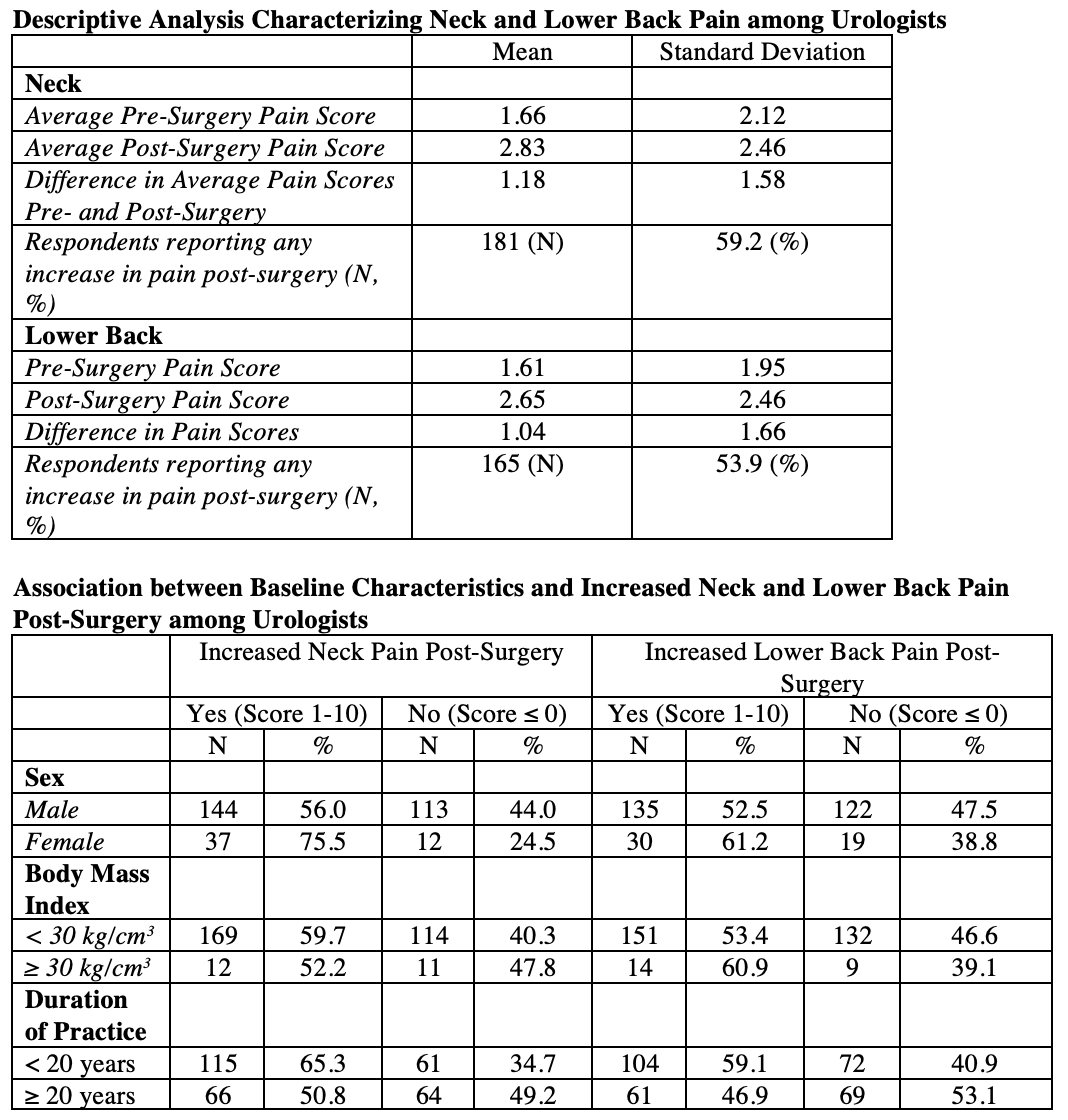Back
Poster, Podium & Video Sessions
Moderated Poster
MP16: Health Services Research: Quality Improvement & Patient Safety I
MP16-16: Work-Related Pain and Ergonomics Education Among Urologists: A Survey Study
Friday, May 13, 2022
4:30 PM – 5:45 PM
Location: Room 228
Jennifer Chyu*, Edward Chang, Erin Dwyer, Sarah Holt, Atreya Dash, Mathew Sorensen, Seattle, WA
- JC
Jennifer Chyu, MD
University of Washington
Poster Presenter(s)
Introduction: Urologists deal with an array of operative environments with unique ergonomic challenges. Work-related musculoskeletal pain is prevalent among surgeons and contributes to burnout, shortened surgical careers, and worse surgical outcomes for patients. We aimed to characterize the current state of operating-related musculoskeletal pain and ergonomics education by surveying Urologists internationally.
Methods: An anonymous, web-based survey of Urologists was sent to the urology professional society mailing lists. The survey collected data on demographics, neck, and lower back pain pre- and post-surgery on a ten-point Likert scale, and education on ergonomic principles. Analysis of data was performed using R Version 4.1.1.
Results: 306 Urologists responded to the survey. The average age was 46.2 years and 84% of respondents were male. The majority of respondents reported experiencing an increase in neck (59%) and lower back (54%) pain post-surgery. Female respondents were more likely to experience an increase in neck pain post-surgery compared to male respondents (OR 2.42, 95% CI 1.21-4.85). Respondents who reported practicing surgery for = 20 years were less likely to experience an increase in neck and lower back pain post-surgery compared to respondents who have been practicing for less than 20 years (neck: OR 0.55, 95% CI 0.34-0.87; lower back: OR 0.61, 95% CI 0.39-0.97). The majority respondents reported “somewhat” or “moderate” knowledge of ergonomics prevention (74%). 46% of respondents reported learning about this topic while operating, while 46% of respondents did not learn about ergonomics during training. 57% and 49% of respondents reported “never” performing micropauses or stretching between surgeries, respectively. 56.9% of respondents take NSAIDs for work related pain.
Conclusions: Most survey responders report an increase in neck and lower back pain after performing surgery. Many did not have formalized ergonomics training and do not employ preventative strategies to optimize ergonomics. This survey study identifies a gap in urology training and a potential area of focus to promote career wellness and longevity.
Source of Funding: none

Methods: An anonymous, web-based survey of Urologists was sent to the urology professional society mailing lists. The survey collected data on demographics, neck, and lower back pain pre- and post-surgery on a ten-point Likert scale, and education on ergonomic principles. Analysis of data was performed using R Version 4.1.1.
Results: 306 Urologists responded to the survey. The average age was 46.2 years and 84% of respondents were male. The majority of respondents reported experiencing an increase in neck (59%) and lower back (54%) pain post-surgery. Female respondents were more likely to experience an increase in neck pain post-surgery compared to male respondents (OR 2.42, 95% CI 1.21-4.85). Respondents who reported practicing surgery for = 20 years were less likely to experience an increase in neck and lower back pain post-surgery compared to respondents who have been practicing for less than 20 years (neck: OR 0.55, 95% CI 0.34-0.87; lower back: OR 0.61, 95% CI 0.39-0.97). The majority respondents reported “somewhat” or “moderate” knowledge of ergonomics prevention (74%). 46% of respondents reported learning about this topic while operating, while 46% of respondents did not learn about ergonomics during training. 57% and 49% of respondents reported “never” performing micropauses or stretching between surgeries, respectively. 56.9% of respondents take NSAIDs for work related pain.
Conclusions: Most survey responders report an increase in neck and lower back pain after performing surgery. Many did not have formalized ergonomics training and do not employ preventative strategies to optimize ergonomics. This survey study identifies a gap in urology training and a potential area of focus to promote career wellness and longevity.
Source of Funding: none


.jpg)
.jpg)